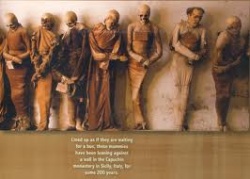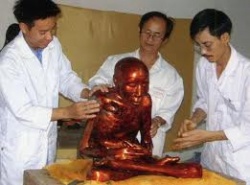Buddhist mummies
Buddhist mummies, also called flesh body bodhisattvas, full body sariras, or living buddhas (Sokushinbutsu) refer to the bodies of Buddhist monks and nuns that remain incorrupt, without any traces of deliberate mummification. These are venerated by some Buddhists who believe they successfully were able to mortify their flesh to death. The practise to purposely make undecomposed bodies is seen as controversial and contradictory in Buddhism believing in impermanence. Many were destroyed or lost in history.
Causes
Some naturally formed. Some Mahayana buddhist monks left instructions to be followed after their deaths, which often included having them buried sitting in a lotus posture, put into a vessel with drying agents (such as coal, wood, paper, or lime) and surrounded by bricks, to be exhumed later, usually after three years. The preserved bodies would then be decorated with paint and adorned with gold. It is a common method in China. Some covered the bodies with clay or salt. According to Victor H. Mair in the Discovery channel series The Mystery of the Tibetan Mummy, the self-mummification of a Tibetan monk, who died ca. 1475 and whose body was retrieved relatively incorrupt in the 1990s, was achieved by the sophisticated practices of meditation, coupled with prolonged starvation and slow self-suffocation using a special belt that connected the neck with his knees in a lotus position, believing that could solve scorpions problems in local population. The mummies of monks (Sokushinbutsu) in Japan practised nyujo (??), which caused their own death by adhering to a wood eating diet made up of salt, nuts, seeds, roots, pine bark, and urushi tea. They were then buried alive in a pine-wood box full of salt connected by a tube for air and would ring a bell signaling they were alive. When the bell stopped ringing the air tube was removed. Japan banned unburying in 1879 and assisted suicide, including religious suicide is now illegal.
List
Theravada
Some names lost or unknown.
- Mahakasyapa
- Thamanya Sayadaw
- Luang Phor Kasem Kemagoh
- Luang Pho Daeng
- Luang Phoo Song
- Luang Phor Wat Paknam or Luang Phor Sodh
- Luang Phor Samrit
- Pra Bit Tar Luang Phor Klai (Phor Than Klai)
- Luang Phor Parn
- Luang Phor Pinak
- Luang Phor Niam Wat Noi, Suphanburi
- Luang Phor Nong Wat Klong Madarn
- Luang Phor Phrom Wat Chongkae
- Luang Phor Sawai Wat Preedahrahm
- Luang Pu Choy Wat Siutumpon
- Luang Phor Mahapoh Wat Klongmor
- Chaokhun Mit
- Luang Phor Tuan
- Ba-xin
Mahayana
Some names lost, Taoists or Way of Former Heaven religion.
- Shonyo (??)
- Zoga shonin (????)
- Ninga (??), a student of Zoga
- Gensan shonin (????)
- Komatsuji shonin (?????)
- Ganzai (???) (nun)
- Kaijin (????)
- Senkaku (priest) (????)
- Angin Kitsudo (????)
- Kyuen (??), a student of Kitsudo
- Jikigyo Miroku (????)
- Nikkan (????)
- Ito Sanko (????), a student of Miroku
- Manzo (??)
- Shan Daokai (???)
- Huizhi (??)
- Zhiyi
- Zhikai (??), a student of Zhiyi
- Zhixi (??), a student of Zhiyi
- Sengche (??)
- Daoxiu (??)
- Dayi Daoxin
- Daman Hongren
- Fapu (??)
- Youxuan (??)
- Suiduan (??)
- Hangxiao (??)
- Wang (???)
- Laode (????)
- Baoyin (??)
- Chang (???)
- Chongyan (??)
- Chunan (??)
- Cunshou (??)
- Daxing (??)
- Daoang (???)
- Daolin (???)
- Daoyin (???)
- Dexiu (??)
- Fachong (??)
- Faqin (??)
- Guting (??)
- Guangyu (??)
- Heluojie (???)
- Faming (??)
- Huanzhong (??)
- Hui (???)
- Huikong (??)
- Huishi (??)
- Huiyan (??)
- Jianzhen
- Jueqing (??)
- Pengpeng (?????)
- Puyuan (??)
- Ruyu (??)
- Shifan (??)
- Shiyu (??)
- Wenyan (????)
- Qingliang Wenyi (????)
- Wuji (??)
- Wulou (??)
- Hangxiu (??)
- Yefang (??)
- Yi Xing
- Zhiyuan (????)
- Zhutanyou (???)
- Ziyu (??)
- Zongyuan (??)
- Niunao (??)
- Baoan (??)
- Canghuan (??)
- Daibing (??)
- Daozhou (??)
- Guangyi (??)
- Guangji (????)
- Huayan (????)
- Huaiyu (??)
- Sengbian (??)
- Wenxi (??)
- Yuanshao (??)
- Jinggan (?????) (nun)
- Lingjiao (?????) (nun)
- Huiyin (???) (nun)
- Yingong (??)
- Mosi (??)
- Danru (??)
- Longshan (????)
- Defeng (????)
- Shengchuan (????)
- Chang'en (????)
- Falong (????)
- Dinghui (????)
- Huade (????)
- Jisheng (????)
- Chushan (????)
- Zhou (????)
- Liu (???) (folk)
- Yibo (????)
- Qin (???) (layman)
- Lingying (????)
- Chen Yi (???)
- Deqin (??)
- T? Ð?o H?nh (???)
- Tu? Tinh (????)
- Wuji (????)
- Shinso Gyojun (???????)
- Kochi (????)
- Tanzei (????)
- Arisada (????)
- Shungi (????)
- Shukai (????)
- Myoshin (????)
- Longde (????)
- Huihuan (????)
- Xianliang (?????) (nun), student of Huihuan
- Benfeng (????)
- Haiyun (????).
- Benru (??)
- Zhou Fengchen (???) (laywoman)
- Tian Zhichao (???)
- Jiaofeng (????) (layman)
- Yuantong (????)
- Xinhui (??)
- Xintian (??)
- Haicheng (??)
- Chanhua (??)
- Lijin (??)
- Zhiyuen (??)
- Faxing (??)
- Yikong (??)
- Yunhe (??)
- Mingyue (??)
- Mingliang (??)
- Siben (??)
- Huaide (??)
- Shixian (??)
- Zhixuan (??)
- Mingzhe (??)
- Shenyuan (??)
- Puqin (??)
- Yuankong (??)
- Haimo (?????)
- Haiqing (???)
- Changjing (????) (nun)
- Zongxu (??)
- Guowu (???)
- Miguang (?????), a student of Hsu Yun
- Dizang(Jin qiaojiao) (??(???))
- Haiyu (????)
- Daxing (????)
- Ciming (????)
- Mingjing (????)
- Puwen (????)
- Renyi (?????) (nun)
- Kuande (????)
- Liaozhen (????)
- Zongsheng (???)
- Shengchuan (????)
- Guoan (??)
- Miaoshan (??)
- Yongsen (??)
- Huang Yulan (???) (laywoman)
- Renguang (????)
- Yongci (??)
- Yang Fuxin (???)
- Wang Chunrong (???) (laywoman)
- Lin Guanrong (???) (layman)
- Yinlian (????)
- Pu-Chao (????)
- De-Hsiu (????) (nun)
- K'ai-Feng (???)
- Wuming (????)
- Qingyan (??)
- Yingmiao (??)
- Mrs Sung (????) (laywoman)
- Ming-chien (????)
- Xie Shide (????) (folk)
- Gao Bangniang (???) (laywoman)
- Gao Guaniang (???) (laywoman), sister of Gao Bangniang
- Miaozhi (????)
- Chen Zhu (??) (Zhaijiao nun)
- Zou Wubi (????)
- Wujinzhang (??????) (nun)
- Huineng
- Dantian (????)
- Hanshan Deqing, teacher of teacher of Ouyi
- Bingong (????)
- Yuet Kai (????)
- Chonghui (????)
- Vu Kh?c Minh (?????)
- Vu Kh?c Tru?ng (?????), nephew of Vu Kh?c Minh
- Chuy?t Chuy?t (??)
- Nhu Trí (????)
- Phochang (????)
Vajrayana
Some names are lost
- Kukai
- Jojin
- Yuihan ajari (??? ??)
- Kogyo-Daishi
- Rinken ajari (?? ??? ??)
- Junkai (??)
- Gekkokai shonin (?????)
- Shinkai shonin (????)
- Bogd Khan
- Zanabazar
- Subhakarasi?ha (???)
- Dashi-Dorzho Itigilov (no known methods of mummification detected, the body's condition ::is not clear for scientists)
- Honmyokai shonin (?????)
- Zenkai (????)
- Chukai shonin (????)
- Shinnyokai shonin (?????)
- Enmyokai shonin (?????)
- Tetsumonkai shonin (?????)
- Komyokai shonin (?????)
- Myokai shonin (????)
- Tetsuryukai shonin (?????)
- Baltung Choimba
- Je Tsongkhapa
- 13th Dalai Lama
- Pantangwa (???)
- Luojinhuan (???) (wife of Pantangwa)
- Dorje Pakmo
- H. E. Karu
- Choeying Dorje Rinpoche (???????)
- Konga oldman (????) (laywoman), a student of 9th Konga Xutugtu
- Konga Gangkar Rinpoche (????. ????)
- Dudjom II (????????)
- Bagsha Dangke (Sheven Davga), Kalmykia, this body is lost

